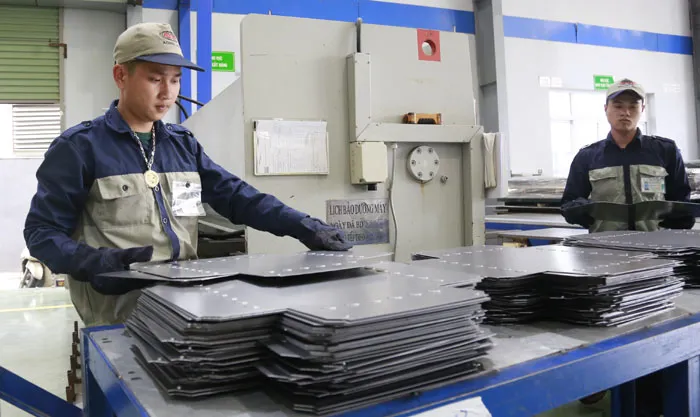Hanoi remains key in nation’s 5-year socio-economic plan: Expert
To aid the economic development process, Hanoi will need to mobilize VND3,100-3,200 trillion (US$134.1-140 billion) in the 2021-25 period.
Hanoi strives to become a green, smart and modern city with high competitiveness against regional cities, in turn playing a key role in realizing Vietnam’s socio-economic plan for the 2021-25 period.
| Production at A Chau Industry Company in Thuong Tin Industrial Park. Photo: Thanh Hai. |
“The year of 2021 holds significant meaning in the city’s efforts to realize its socio-economic development plan for the 2021-25 period,” stated economist Nguyen Minh Phong.
To realize its goal of completing the industrialization and modernization process by 2025, Hanoi has identified five major orientations, three breakthroughs and 11 development plans for different sectors, added Mr. Phong.
During the next five year, Hanoi plans to generate VND1,400 trillion (US$60.86 billion), in which domestic revenue would make up 90% of the total, or VND1,300 trillion (US$56.4 billion).
Meanwhile, the city’s expenditure is expected to reach VND613.7 trillion (US$26.7 billion), with regular spending making up 50% of total expenditure.
Mr. Phong said Hanoi would further reduce land areas for agricultural production, which could stand at 165,000 hectares by 2025, or 49.1% of natural lands. In addition, one third of the total rice cultivated land would be subject for conversion for other purposes.
Hanoi would also auction 2,000 – 3,000 hectares of land to raise fund for infrastructure development.
To aid the economic development process, Hanoi would need to mobilize VND3,100-3,200 trillion (US$134.1-140 billion), in which the state capital could make up 30-31%, domestic private capital of 53-54% and foreign capital of 15-17%.
The priorities for investment would be in fields of national defense, public order, training and education, science, healthcare, sports, and environmental protection.
Containing Covid-19 pandemic-Utmost priority
While the Covid-19 pandemic still lingers in 2021, Hanoi continues to pursue the dual target of both containing the pandemic and boosting economic recovery, with the aim of reaching an economic growth of 7.5% from an estimated of 3.98% last year.
Among measures, Hanoi will give its utmost priority to containing the Covid-19 pandemic, while exerting efforts to ensure speedy economic recovery and economic restructuring.
In 2021, Hanoi is expected to focus on urban planning and development, at the same time allocating resources to address issues of climate change and environmental pollution.
Mr. Phong said Hanoi will continue to streamline the organization and enhance efficiency in operation, which could be reflected by moving to a higher ranking in major indicators such as the Provincial Governance and Public Administration Performance (PAPI) Index, the Satisfaction Index of Public Administration Services (SIPAS), the Public Administration Reform (PAR) Index and the Provincial Competitiveness Index (CPI).
In particular, Hanoi sets strong focus on improving the business/investment environment to further create convenience for people and enterprises in doing businesses.
To help the business community and those severely affected by the pandemic, Hanoi is expected to provide supporting programs in form of incentives on taxes, credit, and land resources to boost production, as well as encouraging the application of IT and technologies in agricultural production.
Hanoi is also drafting plan to accelerate the recovery of the tourism sector, including diversified tourism products and new tourist attraction spots, at the same time pushing for greater disbursement progress of public investment fund.
In 2020, Hanoi posted an economic growth of 3.98%, 1.5 times higher than the national average. This resulted in a nominal gross regional domestic product (GRDP) of VND1,016 trillion (US$44.13 billion) and a GRDP per capita of VND122.7 million (US$5,285), up 2.34% year-on-year.












